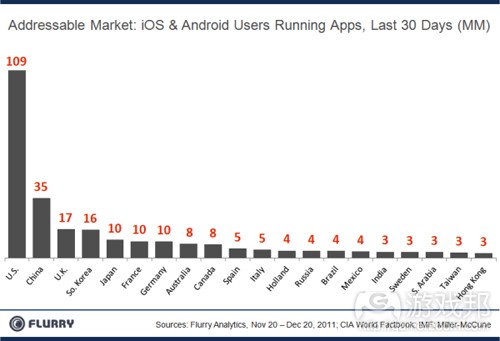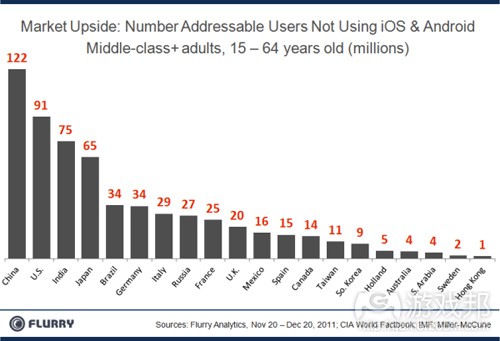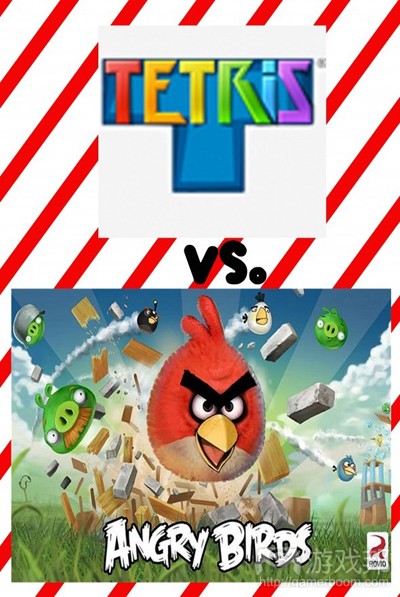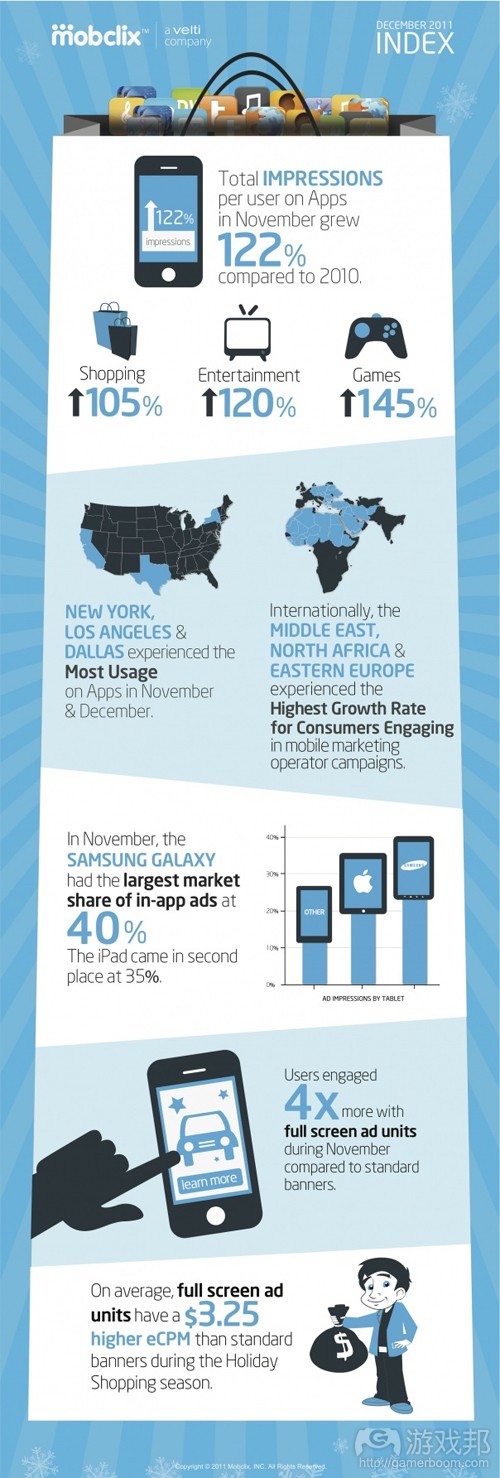每日观察:关注中美iOS和Android应用市场潜力(12.24)
1)移动分析公司Flurry最近发布报告指出(游戏邦注:这项报告数据取自Flurry追踪的14万款以上的手机应用),过去30天中的全球Android和iOS应用活跃安装基数达2.64亿,美国仍是前20个国家中规模最大的市场,活跃安装基数达1.09亿,占比41%。
中国和韩国现已分别跻身第二和第四名,在过去30天中运行应用程序的用户数量超过日本、法国和德国等发达国家。
报告还发现,中国还有1.22亿有能够购买iPhone或Android智能手机,但却尚未采取行动的用户,中国、印度、巴西是三大最有发展潜力的市场。
从智能手机市场发展的成熟度来看(主要以市场覆盖率,即过去30天中运行应用程序的iOS和Android设备用户与可挖掘用户的比值为衡量标准),美国拥有2亿可挖掘的用户,其实际活跃用户则是1.09亿,市场覆盖率达55%。瑞典是市场成熟度最高的国家,可挖掘用户为500万,活跃用户达320万,其覆盖率高达66%;法国市场可挖掘用户为3400万,实际活跃用户为960万,覆盖率达28%。从以下图表可以看出,越靠近右侧的国家,市场成熟度越高。
从以下图表来看,如果排除市场覆盖率,仅看市场发掘潜力,就可以发现美国仍然是首个潜力市场(这与其富裕人口规模庞大有关),其次是中国(拥有13亿人口,但智能手机尚未普及),而印度人口(12亿)虽然仅次于中国,但其可挖掘的市场潜力却较为落后(这可能与其贫穷群体规模较大有关)。
2)Disney Mobile总经理Bart Decrem最近透露,公司将针对手机游戏《Where’s My Water》中的小鳄鱼形象推出周边产品,据AppData数据,该游戏最近位列iOS应用营收榜单第55名,其最新发布的免费版本位居免费应用榜单第14名。
3)The Tetris Company经理Henk Rogers在最近的媒体采访中声称,芬兰开发商Rovio游戏《愤怒的小鸟》只是“流行一阵的风潮”,“只有那些大家会玩20-25年左右的游戏,才能算是经得起时间考验的游戏”;《愤怒的小鸟》虽然很可爱,可以让大家都玩上一阵子,但人们迟早会玩腻,相比之下,《俄罗斯方块》则更像是《生日快乐》这种经久不衰的歌曲。
4)据pocketgamer报道,11 bit studios塔防游戏《异形:地球战区》日前通过亚马逊Appstore发布Android版本。
值得注意的是,该工作室主程序员Bartosz Brzostek仅历时两周就将这款游戏移植到了Android平台。该游戏目前在亚马逊Appstore售价3.99美元。
5)移动广告公司Mobclix最近发布报告显示,在今年11月至12月份,用户对Mobclix平台全屏广告的粘性比一般条幅广告多4倍,总体上看,全屏广告在假期季的eCPM比一般条幅广告多3.25美元。
从该平台的平板电脑应用广告印象来看,三星Galaxy Tab应用中的广告印象所占份额最大(占比40%),居于其次的是占比35%的iPad。
(本文为游戏邦/gamerboom.com编译,拒绝任何不保留版权的转载,如需转载请联系:游戏邦)
1)Kaboom! iOS and Android International Installed Base Expansion
by Peter Farago
In 2007, Apple and Google started a mobile computing revolution. Over the last four years, adoption of this new class of smartphone has been unprecented. With powerful devices, conneced to broadband networks and rich digital stores, an app economy was quickly built on top of it.
Beginning last year, Flurry observed that consumers using apps began expanding beyond early-adopting U.S. and Western European markets, starting to include more emerging economies. In a previous post, we shared details about this shift, highlighting the fastest growing international markets, with emphasis on China’s extraordinary growth.
As 2011 comes to a close, and we look forward to 2012, we size today’s installed base of iOS and Android smart devices (smartphones and tablets) as well as identify markets where the most future upside exists. We start by looking at how many active iOS and Android devices run applications by country.
Using data collected from Flurry’s data-set of more than 140,000 apps running on smart devices worldwide, we get a snapshot of how many iOS and Android devices ran apps over the last 30 days. Note that we gross up our figures to reflect differences in penetration per platform to provide market-level estimates. Among the top 20 countries, the U.S. still makes up the largest chunk of the world’s active installed base, with 109 million out of 264 million, or 41%.
Of note, China and South Korea now hold two of the top five positions, boasting addressable audiences greater than that of more developed countries such as Japan, France and Germany. Also worth noting is that our count of 264 million active units in the market is about half of what Apple and Google publicly state have been activated. The difference is primarily due to old device replacement. Flurry is counting recently used devices versus life-to-date device activations.
With smart device adoption skyrocketing worldwide, we next look at which markets hold the most future promise. With greatly varying disposable income per country, and recognizing that children do not purchase devices, Flurry used available data from several sources to adjust its data for an apples-to-apples comparison. First we used the “adult” population counts from the International Monetary Fund (IMF), which IMF defines as 15 to 64 years of age. Next, we adjusted our numbers based on the size of the middle class in each country, primarily using a study by Miller-McCune. We finally estimated the size of the upper class per country, who by extension can also afford a smart device. After making adjustments, we are left with adult consumers who have the financial means to afford a smartphone device per country. Doing so, populous countries like India, China and Brazil, which also suffer from income disparity, are not over-estimated in our addressable market calculations.
Starting from the left, China has 122 million consumers who do not yet use an iPhone or Android device, but could afford one. In short, this chart represents untapped potential. Emerging economies – China, India and Brazil – make up three of the top five market opportunities. Over the next several years, as these countries continue to modernize, they will significantly expand the worldwide addressable audience for smartphones.
Bringing the data together, we next look at market maturity, which is the measure of how penetrated smartphone devices are among a country’s addressable audience. To illustrate which markets are most mature, we chart the top 10 countries ranked by penetration.
The vertical axis measures our total addressable audience (TAM), which we define as adults, 15 – 64, who are at least middle-class. The TAM per country is represented by the larger, light blue circles. The U.S., with the largest light blue circle, has the largest TAM at 200 million. The horizontal axis shows percent penetration, which is the active user (iOS or Android device that used an app over the last 30 days) divided by the TAM. For example, Sweden is the most mature country with 3.2 million of 5 million (66%) addressable consumers already using iOS and Android devices. France, which ranks 10th in maturity, has 9.6 million of 34 million (28%) consumers using iOS and Android devices. So, from left to right, penetration increases. And from bottom to top, TAM increases. The U.S. leads the world in installed base because its large, addressable audience has been well penetrated, 91 million of 200 million (55%).
Completing our study, we look at the world’s largest addressable markets, regardless of penetration.
Because this chart measures future potential, TAMs are much larger relative to active user bases. The result, visually, is a lot more “light blue.” Many of the world’s largest countries have largely un-penetrated markets, primarily due to standards of living (emerging markets) or increased competition for consumers’ disposable income (developed markets). In either case, the TAM is there, but the adoption hasn’t yet occurred. So, many of these markets are future bets with the time of maturity somewhat variable and unknown. In this chart, the U.S. has both the largest current installed base and market upside. Again, this is because of its unique, well-penetrated and large, affluent population. Next China, given its very large population (1.3 billion), along with a growing middle class who has already begun adopting smart devices, has the world’s second largest market potential. In comparison, even though India has the world’s second largest population (1.2 billion), its TAM is much smaller than China’s because of India’s very low standard of living. The result is that, even though its total population is not far behind China’s, its total addressable market is. Further, the adoption of smartphones and tablets among its TAM has been small. Finally, Japan, the world’s fourth largest market, has a lot of upside given light penetration of iOS and Anroid devices against its large, addressable market.(source:flurry)
2)Disney Has Big Plans for Swampy The Alligator – Disney Mobile’s general manager Bart Decrem has revealed that the entertainment company will be soon be making merchandise and backstory videos for Swampy the Alligator, the hero of its hit mobile game, Where’s My Water. The game has performed well on iOS since its release, and is currently the #55 top grossing app, according to AppData. The newly released free version of the game is the #14 free app.(source:insidemobileapps)
3)Manager of The Tetris Company calls Angry Birds ‘a fad’, Tetris ‘a sport’
by Will Wilson
It can’t be Christmas without the inevitable argument or four, so it’s always good to see major software companies have a mud-slinging match during the festive season.
The Tetris Company, holder of the Tetris license, has lashed out at Angry Birds creator Rovio, calling the company’s game ‘a fad’ in a recent interview with Industry Gamers.
Henk Rogers, manager of The Tetris Company , reasoned that “once people have played [a game] more than 20 or 25 years you can say it’s here to stay, it’s a sport, it’s no longer a fad”
“Angry Birds is cute and everybody plays it for a while, but they get burned out”.
Mixed meta-claus
Just to confuse matters, Rogers later went on to describe Tetris as like the song “Happy Birthday’, it keeps on going”, which is clearly not a sport and is actually quite a short song.
It’s not too surprising that other companies are gunning for Rovio after its Angry Birds franchise hit over half a billion downloads earlier in the year. Comparing their birds to Mario and Disney likely didn’t go down that well with the old guard either.(source:pocketgamer)
4)Award-winning ‘tower offence’ game Anomaly: Warzone Earth lands on the Amazon Appstore
by Alex Whitelock
11 bit studios’s excellent ‘tower offense’ title Anomaly: Warzone Earth, has arrived on Android via the Amazon Appstore (hello, America!).
The game, which picked up a stunning Pocket Gamer Platinum Award on the iPad, sees you planning attacks against a series of alien towers that have taken over a futuristic, war-torn Baghdad.
Each mission sees you plan out and oversee the route your convoy of armoured machines will take through the windy city streets, utilising special weapons like smoke screens to ensure victory.
What’s most impressive about this new Android version of the game is that 11 bit studios’s lead programmer, Bartosz Brzostek, managed to port the title to the platform in just two weeks.
Like the Pocket Gamer staff office, Bartosz’s efforts were powered only by the blackest of coffee (see dev diary below).(source:pocketgamer)
5)Infographic: Holidays are hot for in-app mobile ads
By Kevin C. Tofel
We already knew that mobile advertisements perform better on larger screened devices and now there’s evidence of when the best time of the year is for these ad spots. If you guessed the year-end holiday season, you’d be right according to data from Mobclix, a Velti company.
The mobile advertising company notes huge jumps during the months of November and December, with more engagement in full screen ads. Among the other datapoints, ad impressions found in mobile software with the Samsung Galaxy Tab — not Apple’s iPad — accounted for the most mobile ads in tablet apps. That could be due to more iOS devs using iAds, but still: It’s a rare time the Tab is ahead of Apple’s successful tablet by any measure! This makes sense to a degree: Android app developers tend to rely on in-app ads for revenue vs. iOS developers who successfully generate revenues through app sales.(source:gigaom)















































 闽公网安备35020302001549号
闽公网安备35020302001549号